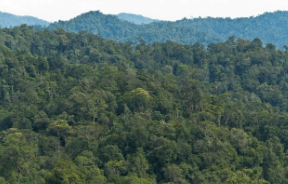Test: Natural Vegetation and Wild Life- Case Based Questions - Class 9 MCQ
10 Questions MCQ Test - Test: Natural Vegetation and Wild Life- Case Based Questions
Read the source given below and answer the questions that follow:
Like its flora, India is also rich in its fauna. It has approximately 90,000 animal species. The country has about 2,000 species of birds. They constitute 13% of the world’s total. There are 2,546 species of fish, which account for nearly 12% of the world’s stock. It also shares between 5 and 8 percent of the world’s amphibians, reptiles and mammals. The elephants are the most majestic animals among the mammals. They are found in the hot wet forests of Assam, Karnataka and Kerala. One Horned rhinoceros are the other animals, which live in swampy and marshy land of Assam and West Bengal. Arid areas of the Rann of Kachchh and the Thar Desert are the habitat for wild ass and camels respectively. Indian bison, nilgai (blue bull), chousingha (four-horned antelope), gazelle and different species of deer are some other animals found in India. It also has several species of monkeys. India is the only country in the world that has both tigers and lions. The natural habitat of the Indian lion is the Gir forest in Gujarat. Tigers are found in the forests of Madhya Pradesh, the Sunderbans of West Bengal and the Himalayan region. Leopards, too, are members of the cat family. They are important among animals of prey.
Q. Which animal is found in hot-wet forests of Assam, Karnataka and Kerala?
Read the source given below and answer the questions that follow:
Like its flora, India is also rich in its fauna. It has approximately 90,000 animal species. The country has about 2,000 species of birds. They constitute 13% of the world’s total. There are 2,546 species of fish, which account for nearly 12% of the world’s stock. It also shares between 5 and 8 percent of the world’s amphibians, reptiles and mammals. The elephants are the most majestic animals among the mammals. They are found in the hot wet forests of Assam, Karnataka and Kerala. One Horned rhinoceros are the other animals, which live in swampy and marshy land of Assam and West Bengal. Arid areas of the Rann of Kachchh and the Thar Desert are the habitat for wild ass and camels respectively. Indian bison, nilgai (blue bull), chousingha (four-horned antelope), gazelle and different species of deer are some other animals found in India. It also has several species of monkeys. India is the only country in the world that has both tigers and lions. The natural habitat of the Indian lion is the Gir forest in Gujarat. Tigers are found in the forests of Madhya Pradesh, the Sunderbans of West Bengal and the Himalayan region. Leopards, too, are members of the cat family. They are important among animals of prey.
Q. Fish account to nearly ................ of the world’s stock.
Read the source given below and answer the questions that follow:
Like its flora, India is also rich in its fauna. It has approximately 90,000 animal species. The country has about 2,000 species of birds. They constitute 13% of the world’s total. There are 2,546 species of fish, which account for nearly 12% of the world’s stock. It also shares between 5 and 8 percent of the world’s amphibians, reptiles and mammals. The elephants are the most majestic animals among the mammals. They are found in the hot wet forests of Assam, Karnataka and Kerala. One Horned rhinoceros are the other animals, which live in swampy and marshy land of Assam and West Bengal. Arid areas of the Rann of Kachchh and the Thar Desert are the habitat for wild ass and camels respectively. Indian bison, nilgai (blue bull), chousingha (four-horned antelope), gazelle and different species of deer are some other animals found in India. It also has several species of monkeys. India is the only country in the world that has both tigers and lions. The natural habitat of the Indian lion is the Gir forest in Gujarat. Tigers are found in the forests of Madhya Pradesh, the Sunderbans of West Bengal and the Himalayan region. Leopards, too, are members of the cat family. They are important among animals of prey.
Q. The natural habitat of the Indian lion Gir is in ............... .
Read the source given below and answer the questions that follow:
Like its flora, India is also rich in its fauna. It has approximately 90,000 animal species. The country has about 2,000 species of birds. They constitute 13% of the world’s total. There are 2,546 species of fish, which account for nearly 12% of the world’s stock. It also shares between 5 and 8 percent of the world’s amphibians, reptiles and mammals. The elephants are the most majestic animals among the mammals. They are found in the hot wet forests of Assam, Karnataka and Kerala. One Horned rhinoceros are the other animals, which live in swampy and marshy land of Assam and West Bengal. Arid areas of the Rann of Kachchh and the Thar Desert are the habitat for wild ass and camels respectively. Indian bison, nilgai (blue bull), chousingha (four-horned antelope), gazelle and different species of deer are some other animals found in India. It also has several species of monkeys. India is the only country in the world that has both tigers and lions. The natural habitat of the Indian lion is the Gir forest in Gujarat. Tigers are found in the forests of Madhya Pradesh, the Sunderbans of West Bengal and the Himalayan region. Leopards, too, are members of the cat family. They are important among animals of prey.
Q. How many animal species are there?
Read the source given below and answer the questions that follow:
Our country India is one of the 12 mega biodiversity countries of the world. With about 47,000 plant species, India occupies tenth place in the world and fourth in Asia in plant diversity. There are about 15,000 flowering plants in India, which account for 6 per cent in the world’s total number of flowering plants. The country has many nonflowering plants, such as ferns, algae and fungi. India also has approximately 90,000 species of animals, as well as a rich variety of fish in its fresh and marine waters. Natural vegetation refers to a plant community, which has grown naturally without human aid and has been left undisturbed by humans for a long time. This is termed as virgin vegetation. Thus, cultivated crops and fruits, orchards form part of vegetation but not natural vegetation.
Q. Plants that have come from outside India are termed as:
Read the source given below and answer the questions that follow:
Our country India is one of the 12 mega biodiversity countries of the world. With about 47,000 plant species, India occupies tenth place in the world and fourth in Asia in plant diversity. There are about 15,000 flowering plants in India, which account for 6 per cent in the world’s total number of flowering plants. The country has many nonflowering plants, such as ferns, algae and fungi. India also has approximately 90,000 species of animals, as well as a rich variety of fish in its fresh and marine waters. Natural vegetation refers to a plant community, which has grown naturally without human aid and has been left undisturbed by humans for a long time. This is termed as virgin vegetation. Thus, cultivated crops and fruits, orchards form part of vegetation but not natural vegetation.
Q. Cultivated crops and fruits, orchards form part of ............... but not natural vegetation.
Read the source given below and answer the questions that follow:
Our country India is one of the 12 mega biodiversity countries of the world. With about 47,000 plant species, India occupies tenth place in the world and fourth in Asia in plant diversity. There are about 15,000 flowering plants in India, which account for 6 per cent in the world’s total number of flowering plants. The country has many nonflowering plants, such as ferns, algae and fungi. India also has approximately 90,000 species of animals, as well as a rich variety of fish in its fresh and marine waters. Natural vegetation refers to a plant community, which has grown naturally without human aid and has been left undisturbed by humans for a long time. This is termed as virgin vegetation. Thus, cultivated crops and fruits, orchards form part of vegetation but not natural vegetation.
Q. India occupies ............... place in the world and ............... place in Asia in plant diversity.
Read the source given below and answer the questions that follow:
Our country India is one of the 12 mega biodiversity countries of the world. With about 47,000 plant species, India occupies tenth place in the world and fourth in Asia in plant diversity. There are about 15,000 flowering plants in India, which account for 6 per cent in the world’s total number of flowering plants. The country has many nonflowering plants, such as ferns, algae and fungi. India also has approximately 90,000 species of animals, as well as a rich variety of fish in its fresh and marine waters. Natural vegetation refers to a plant community, which has grown naturally without human aid and has been left undisturbed by humans for a long time. This is termed as virgin vegetation. Thus, cultivated crops and fruits, orchards form part of vegetation but not natural vegetation.
Q. Ferns, Algae and Fungi are types of:
Study the picture below and identify the type of forests:

Study the picture below and identify the type of forests:




















